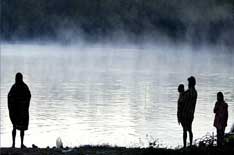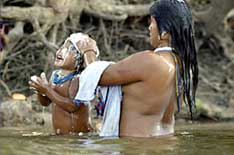
A view of the Xingu River, a major tributary of the Amazon, where the state-run power company, Electronorte, intend to build the Belo Monte dam. Photo: Reuters |
Brazil obtains over 90 percent of its energy from hydroelectric power. In the 1980s, backlash against such big dam projects coalesced in the form of the Brazilian Movement of Dam-Affected People (MAB), one of the only movements of its kind in the world. Conflicts between dam builders and dam protestors have escalated ever since. In 2001, six anti-dam activists who were working to prevent the construction of the Belo Monte dam were murdered. The Belo Monte Hydroelectric Complex is actually an adaptation of an old proposal to dam the Xingu River (a large tributary of the Amazon) that was dropped over 10 years ago in the face of international resistance. In terms of installed capacity, at 11,000 megawatts it would be the world’s third largest hydropower plant.
The Economics
One of the most common accusations levied at Electronorte, the state-run power company creating the $6.6 billion Belo Monte complex, is that the dam won’t function at full capacity during the Amazon region’s lengthy dry season. In order to run at full power year round, the Belo Monte dam must be supplemented by additional dams upstream, which would then necessitate more construction and flooding, as well as the destruction of forest area and the homelands of indigenous peoples. Critics also say that the cost of the project has been underestimated, and refer to past dams, like the Tucuruí project, also in the Amazon, which was budgeted at $4.8 billion, but has cost more than $10 billion so far.
Human Displacement
Most of the thousands who would be affected by the Belo Monte Hydroelectric Complex are indigenous people. A number of indigenous tribes would be affected by the dam — the farmland and the forests in which they live are slotted to be engulfed by the resulting reservoirs. According to anti-dam activists, these people are not being consulted about the fate of their homelands. The dam builders, however, say they have made efforts to minimize the project’s impact on local inhabitants through consultation and by reworking the design to create smaller reservoirs.
Environmental Concerns
The Belo Monte Dam will be located deep in Brazil’s Amazonian interior on the Xingu River, a major tributary of the Amazon. There are a number of potential problems with drastically altering the nature of the world’s most richly diverse ecosystem, including possible threats to a number of species that exist nowhere else in the world. One concern arises from flooding a large expanse of rain forest to create a reservoir. Environmentalists suggest this process releases an inordinate amount of carbon dioxide into the atmosphere when the submerged vegetation begins to rot. Electronorte claims the reservoir has been redesigned to incorporate two canals that would decrease the amount of flooded land by 65 percent; the excavation required to carry out these plans, they say, will be the largest since the Panama Canal. Dam defenders also argue that most of the land that will be swallowed up by the reservoir has already been deforested. Still, critics are just as concerned about problems stemming from the infrastructure that would accompany the construction of the dam. Roads built for the project in the ’80s, for instance, have supposedly allowed illegal loggers to penetrate deeper into the Amazonian interior. Once development of the area begins, it will be hard to prevent land from being divided up and sold to large agricultural or industrial interests.
- Previous: Lesotho/South Africa
- Next: Laos



